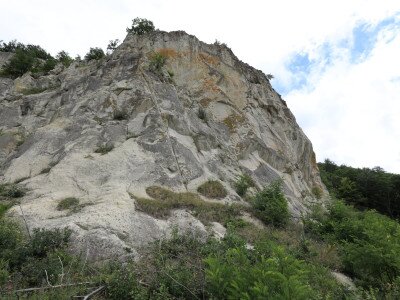
Nem látogatható!
Itt található Magyarország, illetve a Kárpát-medence őstörténetének egyik fontos emléke, a Mátra vulkanikus kőzetanyagának heves kitörései által felszínre került és szép sziklateraszok formájában előbukkanó tari dácittufa.
Aki gyakran jár a Csevice-völgyben, az a kőbánya környékén időről időre népes egyetemista csapatokkal találkozhat. A földtant is tanító egyetemek geológus hallgatói ugyanis tanulmányaik során legalább egyszer meglátogatják a tari Fehérkő-bányát, illetve a vele szemben levő andezit- (vaskő-) bányát - és ha már itt vannak, a csevice-forrásokat is.
Fekvése, megközelítése
A tari dácittufák a Csevice-völgy északi oldalán a Macska-völgyig láthatók, távolságuk a Júlia vendégháztól 1,5 km.
Keletkezése
Az első kitöréssorozat törmelékszórásának nyomán keletkezett az ún. alsó riolittufa, ilyen lepte be az ipolytarnóci lábnyomokat is. 17 millió évvel ezelőtt képződött a középső riolittufa, más néven a tari dácittufa. Ezt találjuk a tari Fehérkő-bányában. A Tari Dácittufa Formáció lényeges időrétegtani határ, a miocén kárpáti korszakát zárja. A dácittufát létrehozó vulkán kitörési centruma a bánya közelében feltételezhető, mivel itt a legvastagabb a formáció (135 méter).
Felszínalaktani jellemzők
A Fehérkő-bánya keleti oldalán a Tari Dácittufa Formáció kopár, gyengén fejlett tufakúpjai, illetve kezdeményei láthatók. Típusos példája a dácittufa eróziójának, ami anyagszerkezeténél fogva eltér a riolittufa pusztulási felszínétől. Jól megfigyelhető a szelektív erózió működése: a puhább portufa jellegű kifejlődés könnyebben, a keményebb tömbök formájában kipreparálódik.
A bánya látványos függőleges falaiban szegregáció csatornák (a piroklasztikum kihűlésekor feláramló gázok csatornái, amiben a nagyobb litoklasztok dúsulnak, a finomfrakció kifúvódik) találhatók.
Jól tanulmányozhatók a kisebb-nagyobb horzsakő darabok. A meglévő falakban jól követhető a két művelési mód időbeli változása: a felső szinten vésés-feszítés, alatta fűrészelés nyomait fedezhetjük fel.
Maga a kőzet szürke, szürkésfehér, zöldesszürke, helyenként lilás vagy rózsaszínes árnyalatú, horzsaköves, rétegzetlen. Általában szívós, kemény, de jól faragható, hasítható. Egertől Miskolcig gyakran alkalmazták a legkülönbözőbb építkezéseknél, valamint útjelzőkövek, keresztek készítésére. Taron és a környező községekben falazó tömbkőként is használták. A kőzet kis térfogatsúlya miatt jó hő- és hangszigetelő.
A bányát - a fejtés esetenként igen nagy termelési vesztesége miatt - bezárták. Két jól járható része van, a felső szinten függőleges, csaknem sima falak vannak, a bányászat nyomaival. Az alsó szint fölé magasodó kőzetfal szinte érintetlen. A messziről is jól látható, néhol vakítóan fehér bánya környékén szép természetes tufaformákat is lehet látni.


























